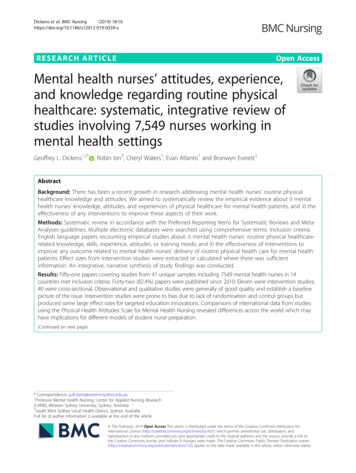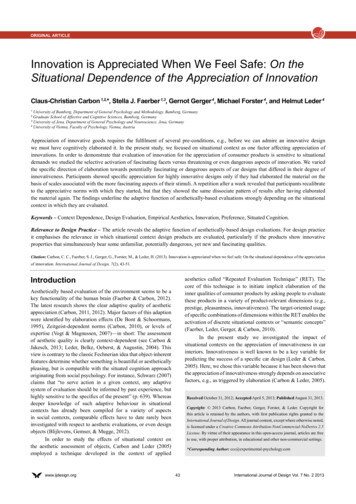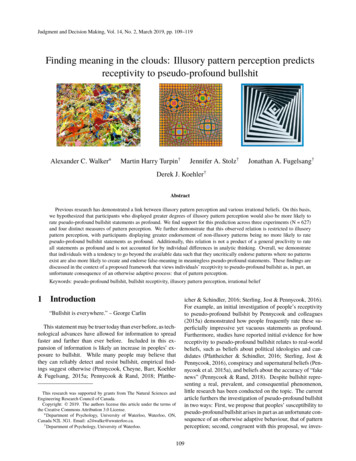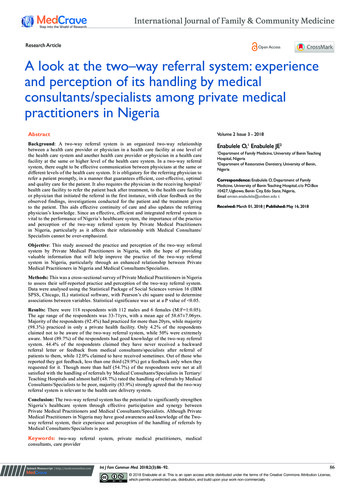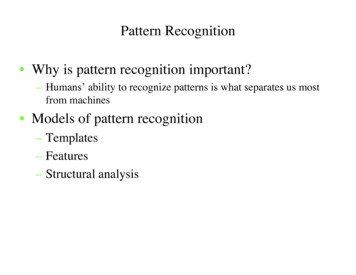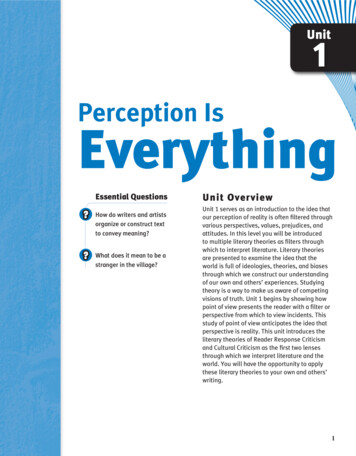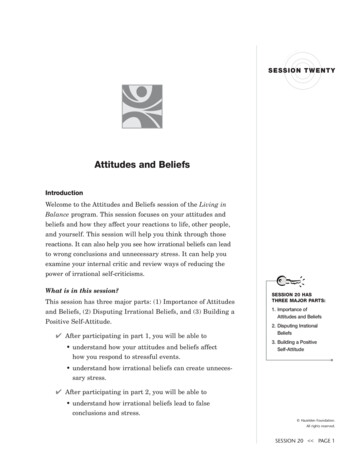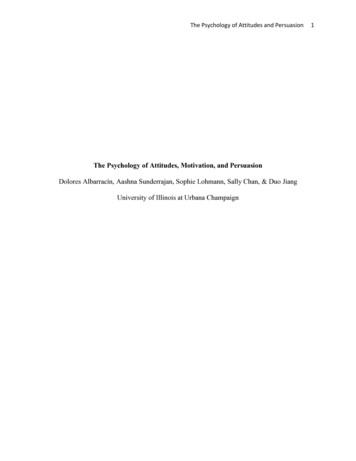
Transcription
ARC Journal of Public Health and Community MedicineVolume 1, Issue 3, 2016, PP 10-18ISSN No. (Online): 002www.arcjournals.orgCommunity Knowledge, Attitudes and Perception towardsMental Illness in Dodoma Municipality, TanzaniaMagreth Benedicto1, Erasmus Mndeme2, David.S.M. Mwakagile3, Tumbwene E.Mwansisya3St. John’s University of Tanzania, School of Nursing, Dodoma, Tanzania2Mirembe Psychiatric Hospital, Dodoma, Tanzania3College of Health Sciences, The University of Dodoma, Dodoma, Tanzania1Abstract: Community attitude and perception towards mental illness play a major role in successful treatmentand social reintegration of people with mental health problems. The aim of this study was to determine theknowledge, attitude and perception of the community towards mental illness in Dodoma Municipality. Amultistage sampling technique was employed to select a sample size of 384 from the study population. Adescriptive cross-section study was employed and semi-structured questionnaire were used in this study. Theresults showed that most of participants 85.9% (n 330) had poor knowledge about mental illness. Fifty onepercent (n 196) could not identify any type of illness, 58.9% (n 226) connoted negative attitude towardspersons with mentally illness. Moreover 75.8% (n 291) of these had poor perceptions about mental illness.Poor knowledge, perception and negative attitude still prevail despite the fact that there is a National MentalHospital located in Dodoma Municipality, Tanzania.Keywords: Attitude, Community, Knowledge, Mental health, Mental illness, Perception.Accessible Summary Mental and behaviour disorders are one of the challenges facing the world today. This studyassessed knowledge, attitude and perception of the community towards mental illness in DodomaMunicipality. The study was completed in Tanzania. The community showed poor knowledge concerning mental illness, inability to identify types ofillness and had negative perception about mental illness. The findings of this study show that, a good number of respondents had little knowledge aboutmental illness. The inability to identify the type of mental illness could be due to lack of healtheducation on mental health and therefore lack of awareness for the appropriate treatment. This study provides the baseline findings for supporting health workers to empower thecommunity members regarding knowledge of mental illness, in order to change the attitudes andperception of the community, as well as establishing health seeking behaviour for treatment ofmentally illnesses.1. INTRODUCTIONMental illness (MI) is the term used to describe a broad range of mental and emotional conditions. Itis also refer to mental impairments other than mental retardation, organic brain and learningdisabilities (WHO, 2001). MI can be experienced over many years; the type, intensity and duration ofsymptoms vary from person to person. The most common forms of MI are anxiety disorders anddepressive disorders.Mental and behaviour disorders are so prevalent that more than 25% of people at a global level areestimated to experience this condition at some point in their life time. They affect each part of fabricof society including poor, rich, young or adult (World Health Report 2001).The prevalence is on the increase each day as reported by the National of Mental Health in the UnitedStates of America (2003) indicated a probability of 20% of the population would be affected by somekind of mental illness at any one point of time of their lives and that a probability of 25% of peoplewould have been familiar with someone with Mental illness. ARCPage 10
Magreth Benedicto et al.Studies have shown that people have limited knowledge and negative perception about mentalillnesses in the community, and whenever there is any knowledge, it is based on prevailing localunderstanding of the nature and causation of MI (Asuni et al. 1994). People’s beliefs regarding MIshould not only be known, but the purpose of their beliefs should be understood; such attitudes andbeliefs about MI can only be studied within a cultural context (Gureje et al.2006).Community attitudes influence the help seeking behaviour of mental health sufferers. Ignorance aboutadvances in the diagnosis and management of MI, the availability of effective treatment, and the fearof stigmatization may prevent people with mental disorders from seeking professional help (Hugo etal. 2003). Moreover, the community attitude and perception towards behaviour disorder or mentalillness play a major role in successful treatments and social reintegration of the mentally ill persons.Also, these help in the determination of help seeking behaviour and adherence to drug treatment(Hugo et al. 2003).Mental illness is a major problem in which two thirds of people who require treatment for MI havebeen reported that do not seek help because of stigma associated with the illness and its treatments(Stuart 2005). Since MI is a major problem globally and it is on the rise, therefore a study whichexplore the community’s knowledge, attitudes and perceptions towards mental illness might useful toameliorate this problem. There are numerous studies on knowledge and perception towards mentalillness. However to best of our knowledge, to date, there is no any study explored the communityknowledge, attitude and perception towards MI in Dodoma Municipality, Tanzania.2. METHODSThe research design was a descriptive cross-sectional study a quantitative method.2.1. Inclusion CriteriaThis study included people aged 18 years and above residing in Dodoma Municipality who were bothmales and females.2.2. Exclusion CriteriaThose aged less than 18 years, refusal to participate, seriously ill persons, mentally sick and failure tospeak Swahili or English were not included because consent was needed before administering thequestionnaire.2.3. Sampling TechniqueA multistage cluster sampling was adopted for this study. In the first stage, by the use of the lotterymethod, one division among the four divisions of the Municipality of Dodoma was randomly selected.In the second stage, by using simple random sampling method, wards were selected from division thatwas selected in the first stage. In the third stage streets were chosen from the wards, which wereobtained in the second stage. In the fourth stage, households were enumerated from each selectedstreet and then were randomly chosen so as to get the required sample size. Any participant aged 18years – old or above, from each household was considered a respondent for this study. In case of anyrefusal to participate, the replacement was made.2.4. Methods of Data CollectionData was collected from the respondents using a semi-structured questionnaire. The content of thequestionnaire included socio-demographic variables, knowledge of the mental illness and its causes,attitude and perception of community members about mental illness. The sources of the questionnairewere from Ng and Chan (2000) a modified version of the questionnaire about mental illness in theChinese Community; but modification was made to suit this study. A semi-structured questionnairewas adopted in this study in order to allow the respondents to give out their views concerning thequestions asked. The questionnaire was designed in English language and then sent to the Englishdepartment and then to the Kiswahili departments at St. John’s University of Tanzania (SJUT) fortranslation into Swahili language. Finally it was again sent to the English department (SJUT) for finalediting and to check for its validity.2.5. Validation of Research InstrumentIn order to test validity of the research instrument, pilot study was done before the actual study, whereby 20 participants from two villages with characteristics similar to the study participants wereinterviewed. The participants included in the pilot study were not included in the actual study. InARC Journal of Public Health and Community MedicinePage 11
Community Knowledge, Attitudes and Perception towards Mental Illness in Dodoma Municipality,Tanzaniaorder to measure for reliability, Cronbach’s alpha was calculated and the value of 0.791 was obtainedfrom the data collected from the pilot study. Then, the researcher made the necessary corrections andmodification of the instruments which were used in the actual study.2.6. Data AnalysisThe data were entered, cleaned and then analyzed by using the Statistical Package for Social Sciences(SPSS 17). Results are also presented using bar charts and graphs, which are used for theinterpretations and discussions. Descriptive analysis was performed for proportions, percentages,means and their corresponding standard deviations.2.7. Scoring SystemKnowledge on mental illness was scored against questions which were asked. All responses weregiven equal weight. The mean score was calculated by taking total scores of knowledge on mentalillness divided by the total number of all study participants; the correct answer was awarded one pointand the wrong one zero point. Total knowledge score was 20 with a mean of 11.4, total score forattitude was 7 with a mean of 2.71 and total perception score was 3 with a mean of 1.21.The mean score was used as a cutoff point to categorize the level of knowledge on mental illness.Respondents who got above the mean score were categorized as having a good knowledge while thosewho got less than the mean score were categorized as having poor knowledge towards mental illness.2.8. Ethical Issues and Confidentiality ConsiderationThe ethical approval to conduct the study was obtained from the Research and PublicationsCommittee of the University of Dodoma. Permission to conduct the research was obtained from theMunicipal Director of the Dodoma Municipality. During the data collection, respondents wereinformed on the purpose of the study. Before questionnaire administration, consent form was given toeach participant to sign and no name was required. In order to allow them to make an informedchoice, informed consent included description of the aim and advantages of the study, the foreseeableand anticipated risks, care for psychological trauma that could result from the study and its durationwere stipulated. The participants were free to withdraw from the study at any time when the feel sowithout any penalty. Furthermore, to maintain privacy and confidentiality the answeredquestionnaires were kept and locked safely at a place where only the principle investigator can haveaccess.3. RESULTS3.1. Social Demographic CharacteristicsTable1. Distribution of the study sample by socio-demographic characteristics (N 384)ParticularGenderReligionAgeMarital statusEmploymentCategory 5-4445-5455 loyedEmployedSmall scale businessARC Journal of Public Health and Community MedicineFrequency and percents 23.7)Page 12
Magreth Benedicto et (1.3)This study was done from December 2011 to June 2012. A total of 384 respondents were interviewedin which n 230 (59.9%) were males. Mean age was 34.3 (SD 2.3) years. With regards to educationcategory n 159 (41.4%) of respondents were secondary educated, n 206 (53.6%) were married, n 217 (56.5%) were Christians and n 162 (42.1%) of the respondents were employed. The descriptionon Table 1 above provides the detailed results of socio-demographic characteristics found in thisstudy.3.2. Community Knowledge of Mental IllnessMeasurement of knowledge of mental illness focuses mainly on the general understanding of mentalillnesses without necessarily focusing on the knowledge of specifics, knowledge of common signsthat describes one to have a mental illness, knowledge of types, knowledge of causes and knowledgeof treatment options for mental illnesses.Aiming at obtaining the respondents' broad knowledge about mental illness, the variables wereassessed by asking the responded on how much they knew about mental illness. More than half of therespondents n 225 (58.6%) reported little knowledge of MI, as opposed to less than one tenth n 32(8.3%) who claimed a good knowledge about MI. The description on Table 2 below provides thedetailed results of knowledge that was found in this study.Table2. Community knowledge on mental illness (N 384)ResponsesA good dealA littleVery littleDon't .3. Community Knowledge on Sign and Symptoms of Mental IllnessNinety four percent (94.3%, n 362) of the respondents reported to have had ever seen a MIP and n 22(5.7%) had never seen one. Common symptoms of MI reported by respondents were abnormalbehaviors n 183 (50.3%), and talking alone n 50 (13.7%) as indicated by Figure 1 below.Figure1. Distribution of study population by knowledge on signs and symptoms of mental illness (N 364)3.4. Community Knowledge on Types of Mental IllnessResults shows that, a total of respondent n 196 (51.0%) did not know the types of MI while druginduced psychosis was reported by many respondents; n 66 (17.2%). Further description of whatrespondents reported about the types of mental illness are found in Figure 2 below.ARC Journal of Public Health and Community MedicinePage 13
Community Knowledge, Attitudes and Perception towards Mental Illness in Dodoma Municipality,TanzaniaFigure2. Distribution of study population by knowledge on types of mental illness (N 384)3.5. Community Knowledge of Causes of Mental IllnessSubstance abuse (alcohol and/or drugs, but mainly the latter) was identified by majority ofrespondents (n 289 (75.3%)) as a causes of MI, while very few n 40 (10.4%) agreed that cursescould be causes of mental illness. Many other causes were identified by respondents to be the causesof mental illness as is shown in Figure 3 below.Figure3. Distribution of study population by knowledge on causes of mental illness (N 384)3.6. Community Knowledge about Treatment of Mental IllnessOne among other, in the measurement of knowledge of mental illness, was knowledge of treatmentoptions. Total number n 330 (86.2%) of respondents, identified mental hospital/institution to be thetreatment option for mental illnesses and while other group of respondents n 148 (38.5%) identifiedcounselling to be their option for treatment of mental illnesses as summarized in Figure 4 below.ARC Journal of Public Health and Community MedicinePage 14
Magreth Benedicto et al.Figure4. Participants’ knowledge on treatment measures of mental illness (N 384)When respondents were asked if a mentally sick person could live a healthy life in the community, n 205 (53.4%) said no. Stigma was cited as the reason for not living a health life by n 120 (60.9%)while n 254 (66.1%) reported that they cannot make friendship with a MIP. Other findings areindicated in Table 3 below.Table3. Attitudes and perceptions toward mental illness among the participants in the study sample (N 384)ResponsesLive health life in community?Reasons for Not living health life (n 197)Reasons for mentally ill personshealthy life in communityYesNoStigmaPoor thinkingCommunity is afraid of themHarm/killOtherParticipantsFrequency (n)1792051202824205TreatmentSupportInvolvingNo veViolencePoor thinkingGo 33.96.8Percent (%)46.653.460.914.212.22.5to liveMake friendshipReason for not making friendship withMentally sickReason not to socialize in the communityA total of n 193 (50.5%), of the participants reported that a MIP cannot do a regular job when askedif a mentally ill person could do a regular job (figure 5); while n 69 (35.6%) reported that they cannothave a regular job because they will be making mistakes and ruin the job (Table 4).Table4. Participants’ perception on reasons for Mental Ill People not to do regular job (N 194)frequencypercentResponses(n)(%)make mistakes6935.6poor concentration5829.9causes damage4925.3need treatment first178.8other10.5ARC Journal of Public Health and Community MedicinePage 15
Community Knowledge, Attitudes and Perception towards Mental Illness in Dodoma Municipality,TanzaniaEighty six percent, n 332 (86.5%) of the study population reported that they will feel good if a mentalhealth facility was set up in their community and the reasons are summarized in Table 5 below.Table5. Participants’ attitude towards mental health facility set up in the community (N 379)ResponsesSave the patientsReduce the number of patientsCenter of educationIncrease manpowerBring noiseMay harm peopleIncrease interactionMove awayFrequency (n)1846249272612109Percent (%)48.516.412.97.16.93.22.62.44. DISCUSSIONTo best of the researcher’s knowledge, this is the first study to explore the community knowledge,attitudes and perception towards mental illness in Dodoma municipality. The outcomes of this studysuggested that knowledge about mental illness was poor in Dodoma community.In the present study, the majority of the respondents (41.1%) had secondary school education whichimplies that one would expect that they could have sufficient knowledge and good perceptions aboutMI, and therefore have positive attitudes towards people with mental health problems. However, onthe contrary, their knowledge of MI was found to be poor. The reason behind could be due to theabsence of mental health education program to the community members.The findings of this study showed that a good number of respondent, 58.6% had little knowledgeabout MI. These further indicated that they could react strangely to someone who is mentally ill. Inaddition, 50.3% of the respondent claimed that they would recognize a person with mental healthproblems by his or her abnormal behaviour. This kind of perception would induce the community tobrand anyone with abnormal behaviour as being mentally ill even when this person might be merelyacting out. Moreover this implies that the community would not be able to recognize a person inremission or less severe phases of MI. This finding is in agreement with what was found in a studydone in Ethiopia by Deribew & Tamirat (2005) which reported 60% of the respondents reportedabnormal behaviour as the sign of MI.Despite the fact that a great number of the respondents (94.3%) in this study reported to have seen aperson with mental health problems, they could not identify the type of MI the person was sufferingfrom. This could be due to the fact that in Dodoma, one is likely to see a MIP because a mentalhospital is located in this community. The inability to identify the type of MI could be due to lack ofhealth education on mental health and therefore lack of awareness of the types of MI. Theunawareness can curb the capability to help a MIP seek proper treatment and in turn lead tomisperception about MI and negative attitude towards people with mental health problems.The identification of substance abuse, drugs in particular, by most of the participants (75.3%) in thisstudy as a major cause of MI can make members of the community to be prone to sweepinggeneralizations or stereotyping that all people with mental health problems are drug and/or alcoholaddicts. This finding concurs with what was found in a study done in Nigeria by Gureje et al. (2005)in which substance abuse was stated to be the major cause of MI by 80.8% of respondents.The finding in this study show that there was almost an equal split between those (53.1%) whoasserted that poverty was the cause of MI and those (46.9%) who disagreed. These results are inagreement with the findings of the study conducted by Deribew and Tamirat (2005) which found outthat 55% of the respondents chose poverty. Furthermore, the observations indicate that the studypopulation did not attribute heredity and family problem as being possible cause of MI. This impliesthat the study population was unaware of other possible causes of MI.This also underscores the belief of the Dodoma community that substance abuse is the prime cause ofMI. This ignorance could result into negative perceptions about the condition.The finding in this study shows that the majority of the respondents (86.2%) mentioned the bestmodel of treatment as the hospital concurs with what was found in a study by Kabir et al. (2004) inNorth Nigeria. However, this finding is in disagreement with what was found in a study by Gureje etARC Journal of Public Health and Community MedicinePage 16
Magreth Benedicto et al.al. (2005) in Nigeria in which traditional healing was the most preferred treatment. The preference ofhospital treatment of MI noted in this study (86.2%) could be attributed to a number of reasons suchas higher education of the study population, the presence of a mental hospital in Dodoma andreligiousness of the studied community.In this study, negative attitudes towards people with mental health problems were very prevalentamong the study population (58.9%) indicated by responses such as MIP cannot live a better life andthat they cannot make friendship with them. This is in agreement with what was found in study doneon health workers in Delta State in Nigeria by Kamla (2009). Factors which facilitated this negativeattitude towards MI included stigma, violence behaviour of MIP, impaired cognitive functioning andlack of knowledge towards MI among community members. The findings in this study are alsosupported by the study done in Kinondoni Tanzania by Chikomo (2011).Also the responses such as MI cannot perform a regular jobs, are aggressive and dangerous indicatethat perceptions of the study population towards people with mental health problems generally poor.These perceptions are true only for patients in the acute phase of MI but not when the patients are inremission or after getting effective treatment. Although majority of respondents said would feel goodif a mental health facility is set up in the street, some of the explanations would reduce the number ofpatients in the street implies that they have a negative attitude and poor perception toward mentalillness.5. CONCLUSIONPoor knowledge, perception and negative attitude still prevail in Dodoma Municipality despite thefact that there is a National Mental Hospital located here.This was due to lack of community mental health education programs. Therefore there is a need forcommunity mental health education in order to improve the knowledge, attitudes and perception ofthe public towards MI. This may encourage early health seeking behavior, as well as better treatmentoutcomes.This research provided a baseline to health workers to empower the community members regardingknowledge of MI, in order to change the attitudes and perception of the community, as well as thehealth seeking behaviour of people with mental health problems.Also to inform the mental health policy developers/makers of the mental health curriculum, todevelop programs which will help mental health care providers to assist the community, provide careand facilitate mental health education effectively. And finally to stimulate further research regardingmental health knowledge, attitudes and perception, in order to improve knowledge and a change in theattitudes and perception of the community, as well as the health seeking behaviour of people withmental health problems.RECOMMENDATIONThe Ministry of Health and Social Welfare should sensitize the community, through campaigns andworkshops in churches, schools, Non Governmental Organisations and all sectors raise communityawareness and to modify the negative attitudes and perception of the community towards peoplesuffering from MI.There should be educational programs conducted by mental health care providers for rehabilitation ofpeople with mental health problems and their families in the community.More qualitative research should be done to explore more on the factors which contribute to negativeattitudes and poor perception of people living with mental illness.REFERENCESAsuni T., Schoenberg F. & Swift C. (1994), editors: Mental Health and Disease in Africa. 2nd edn. pp42-53. Spectrum Books Ltd, Ibadan.Bourget B. & Chenier R. (2007) Mental Health Literacy in Canada: Phase One Report on MentalHealth Literacy Project. Canadian Alliance on Mental Illness and Mental Health, Canada.www.camimh.ca/files/literacy/MHL REPORT Phase One.pdfARC Journal of Public Health and Community MedicinePage 17
Community Knowledge, Attitudes and Perception towards Mental Illness in Dodoma Municipality,TanzaniaChikomo J.G. (2011) Knowledge and Attitude of the Kinondoni Community Towards MentalIllness.Dissertation presented to the university of Stellenbosch in South Africa. URL: http://hdl.handle.net/10019.1/6562Cochran W.G. (1997) Sampling Technique (3rd Ed.) New York: John Wiley & sonsDeribew A. & Tamirat Y. S. (2005) How are mental health problems perceived by a community inAgaro town? Ethiopia Journal of Health Development 19(2), 153-159.Gureje O., Lasebikan V. O., Ephraim-Oluwanuga O., Olley B. O. & Kola L. (2005) CommunityStudy of Knowledge of and Attitude to Mental Illness in Nigeria. British Journal of Psychiatry186, 436-441. e O., Olley B. O., Ephraim-Oluwanuga O. & Kola L. (2006) Do Beliefs About CausationInfluence Attitudes to Mental Illness? World Psychiatry 5(2), 104-107. http://www. ncbi.nlm.nih.gov/pmc/articles/PMC1525129/Hugo C. J., Boshoff D. E. L., Traut N. Z. & Stein D. J. (2003) Community Attitudes Towards andKnowledge of Mental Illness in South Africa. Social Psychiatry and Psychiatric Epidemiology38(12):715-9. 003-0695-3Jorm A. F., Angermeyer M. C. & Katschnig H. (2000) Public Knowledge of and Attitudes to MentalDisorders: A Limiting Factor in the Optimal Use of Treatment Services. In Andrews, G. &Henderson, S. (Eds.). Unmet Need in Psychiatry: Problems, Resources, Responses. 399-413.Cambridge: Cambridge University Press.Kabir M., Iliyasu Z., Abubakar I. S. & Aliyu M. H. (2004) Perception and Beliefs about MentalIllness among Adults in Karfi Village, Northern Nigeria. BMC International Health and HumanRights 4, 3. doi: 10.1186/1472-698x-4-3.Kamla R. (2009) Knowledge, Beliefs and Attitudes of Health Care Providers towards the Mentally Illin Delta State, Nigeria. Annals of General Psychiatry 8,19. doi: 10.1186/1744-859X-8-19.Razal G. & Hajib H. (2000) Community Attitudes towards the Causes of Auditory Hallucination inSaudi Arabia and Canada. Acta Psychiatric Scandinavia 114, 303-318.The World Health Report (2001) Mental health: New understanding; New Hope. WHO, GenevaWHO (1994) Mental Health Care in Developing Countries; A Critical Appraisal in ResearchFindings. Technical Report Series, 698, WHO, Geneva, Switzerland.ARC Journal of Public Health and Community MedicinePage 18
community members regarding knowledge of mental illness, in order to change the attitudes and perception of the community, as well as establishing health seeking behaviour for treatment of mentally illnesses. 1. INTRODUCTION Mental illness (MI) is the term used to describe a broad range of mental and emotional conditions. It
